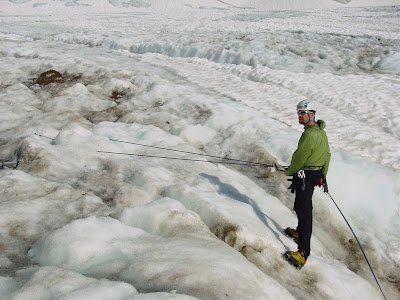In hard frozen snow or on ice, one option is to create a bollard. A bollard is essentially a tear-drop shaped pillar that is cut into a frozen surface with an ice axe adze. The rope is then wrapped around the bollard for the rappel. Once the rappel is completed, the climber can simply pull the rope.
Bollards are not the strongest anchors available, but they are quick and effective. If you choose to use a bollard, it is important to do two things. Back them up and reset the rope after each rappel.
To back-up a bollard, create the bollard and then preset the rope. Place a piece of snow protection (e.g. a picket buried as a deadman) and then loosely clip a sling to both the piece and to the rope. Once this is set-up, the heaviest person with the heaviest pack should rappel first. The theory is that if the heaviest person with the heaviest pack doesn't blow out the bollard, then a lighter person should be able to remove the back-up piece and safely rappel.
To reset the rope after each rappel, simply treat the rope like dental floss. Pull on each end of the rope once your down. Resetting the rope like this will ensure that it doesn't freeze into place and get permanately stuck.
 An Ice Bollard backed-up by an Ice Screw
An Ice Bollard backed-up by an Ice ScrewSnow and ice bollards are a quick and effective style of anchoring that avoids leaving trash -- or expensive gear -- behind. Practice with this style of rappel anchor will lead to a solid and safe understanding as to how one should employ them effectively...
--Jason D. Martin

